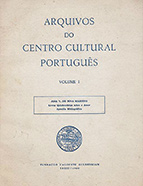

................................
Topics included Portuguese philology and literature, anthropology and archaeology, history, art history, and geography, with careful consideration given to the balance of these subjects. Additionally, attention was given to the authors' nationalities, ensuring an equal representation of Portuguese and French contributors. It is noteworthy that a substantial portion of the journal was devoted to critical reviews of Portuguese works, with contributions mainly by French and Portuguese authors; however, over time, French authors have come to predominate.
This publication has also evolved over the years. By the late 1960s, when both the Bulletin des Etudes Portugaises and the Arquivos do Centro Cultural Português were being published, each aimed to foster closer Portuguese-French cultural ties, although the Bulletin had shifted to an annual publication cycle. At that time, the president of the Calouste Gulbenkian Foundation joined the president of the Diréccion Géneral des Affaires Culturelles et Téchniques and the rector of the University of Toulouse on the Comité de Patronage for the Bulletin des Etudes Portugaises . Clear parallels can be drawn between these two publications. This alignment is evident not only in the predominance of French authors contributing to both journals but also in their organisational structures. By the late 1960s, the Bulletin was organised into three main sections, also found in the Arquivos : Etudes, Chronique des Livres (dedicated to critical reviews), and Collóques et Congrés . However, in the 1970s, additional sections were introduced, as seen in Arquivos , including one dedicated to honours, titled Hommages et Mélanges .
Throughout its various issues, the magazine features illustrations, often in colour, and photographs. Over time, however, the prominence of images in its design has decreased. Although it is an annual journal, in certain years two issues were published, either as commemorative editions or indexes. The publication ultimately comprised 32 volumes, divided into six series. The first series included volumes I to V (1969-1972), the second volumes VII to XI (1973-1977), the third volumes XIII to XVII (1978-1982), the fourth volumes XIX to XXIII (1983-1987), the sixth volumes XXV to XXIX (1988-1991), and the seventh series volumes XXXI and XXXII (1992-1993). Strangely, there is no fifth series, as it skips directly from the fourth to the sixth. Regarding the print run, it is known that during the first series, between 800 and 850 copies were printed. The publication initially comprised an average of 600 to 800 pages, expanding in subsequent years to over 1,000 pages by 1982 and more than 1,100 pages in 1987.
This work is financed by national funds through FCT - Foundation for Science and Technology, I.P, in the scope of the projects UIDB/04311/2020 and UIDP/04311/2020.
